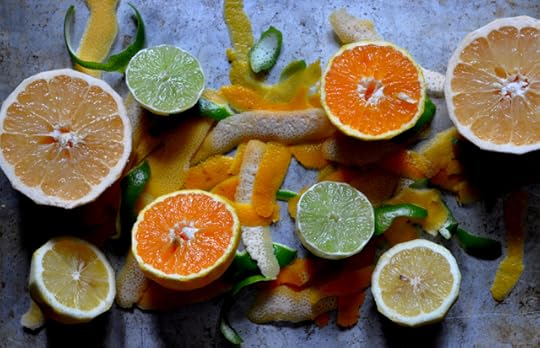How to Make Your Own Tonic Water
Regular Food in Jars contributor Alex Jones is here to with a how-to post designed to help you make tonic water syrup! A fun DIY project for an August weekend. – Marisa

When hot weather comes to Philadelphia, that’s my cue to pick up a bottle of gin — because there’s no better quencher at the end of a long, hot bike commute or gardening session than a bright, herbaceous gin and tonic.
In recent years, I’ve started investing in better, locally produced gins to make my favorite summertime cocktail: bottles of Philadelphia Distilling’s Bluecoat and Palmer Distilling’s Liberty Gin are made in the city; Manatawny Still Works’ Odd Fellows Gin is produced about an hour outside Philly in Pottstown. All three are delicious in a crisp G&T.
With quality craft gin, homemade seltzer (thanks to my secondhand SodaStream), and fresh-squeezed lime juice, I found myself just one ingredient away from a truly bespoke cocktail: homemade tonic water.
While I’d had delicious homemade tonic water thanks to a fellow swapper at the Philly Food Swap, I’d never made it myself. Luckily, the indispensable David Leibovitz had a recipe.
Very important note: David’s recipe also includes a link to this essential guidance on how to make your own tonic and avoid cinchonism, an unpleasant condition caused by overconsumption of quinine, the compound in chinchona bark that gives tonic water its signature bitter flavor and tannic quality.
As far as I can tell, this recipe should be safe as long as you follow guidelines on selecting cut bark rather than powdered, strain well and let sediment settle, limit homemade tonic consumption to one cocktail’s worth per day and make sure to dilute the syrup with seltzer by at least 50%. That said, I’m not a doctor or a scientist, so be sure to read this information thoroughly and follow directions.
Or — to create a tonic water that you can consume with abandon — swap out the chinchona bark with a similar quantity of black tea, which can serve as a comparable bittering agent.
Warnings aside, this recipe is simple to make and delicious to enjoy. Zest and juice citrus fruits, select spices and herbs to customize the flavor, simmer it all together, and let the mixture steep for a few days in the fridge.
Strain the tonic well, let it sit overnight, and pour off (or, for a slightly higher yield, siphon off) the syrup, leaving the chinchona and spice powder that’s settled to the bottom behind.
With a mix of citrus, lots of lemongrass, some tropical spices and an extra limey kick from makrut lime leaves, the finished product smells and tastes delicious — like a really complex, fresh version of lime-flavored jellied citrus candies underlined by a hint of bitterness. Mix with an equal amount of simple syrup, then cut that by at least 50% with fizzy water to use in (occasional) cocktails.
As someone who tries to work in healthier habits without totally abandoning indulgence as I progress through my 30s, turning my favorite boozy quencher into something extra-delicious that should really only be consumed in occasional, moderate doses makes a lot of sense to me.
PrintHomemade Tonic Water
Ingredients
The zest and juice of an organic lemon, lime, orange, and grapefruit1 quart water
3 ounces lemongrass, chopped (fresh or frozen will work)
3 tablespoons citric acid
1/2 cup chinchona bark (cut, not powdered; available through Penn Herb Co.)
2 makrut lime leaves (fresh or frozen will work)
1/4 tablespoon whole black peppercorns
3 star anise
1 teaspoon Cape May Sea Salt or other coarse sea salt
Instructions
Be sure to consult these guidelines before making or consuming homemade tonic water.Combine all ingredients in a nonreactive saucepan over medium-high heat. Bring to a boil, reduce heat, cover loosely, and simmer for 15 minutes. Remove the pot from the heat, uncover, and let cool to room temperature.
Funnel the mixture into a half-gallon glass jar or a two-quart nonreactive vessel. Cover and refrigerate for two days, giving it a stir or a shake a few times each day.
Strain the mixture through a fine-mesh strainer and discard the solids. Strain again through several layers of cheesecloth, a coffee filter, or muslin into a nonreactive vessel. Cover and refrigerate overnight to allow sediment to sink to the bottom.
The next day, pour or siphon off the mixture into a new nonreactive vessel, taking care not to disturb or pour out any sediment at the bottom (you can strain once more through cheesecloth or a coffee filter after pouring off the mixture to be extra-sure that you've removed any remaining trace of cinchona powder if you like). Choosing to pour off the tonic water will result in a slightly smaller yield than siphoning.
Combine the tonic water with an equal amount of simple syrup and stir or shake gently to combine. Store in the fridge loosely covered for up to one year. To serve, cut the tonic syrup with seltzer water by at least 50%. Consume in moderation. 3.1http://foodinjars.com/2017/08/12160/
Related Posts:
How to Make Elderflower Cordial
How to Build a Summertime Cheese Board
June Mastery Challenge: Foraged Berry Jam



